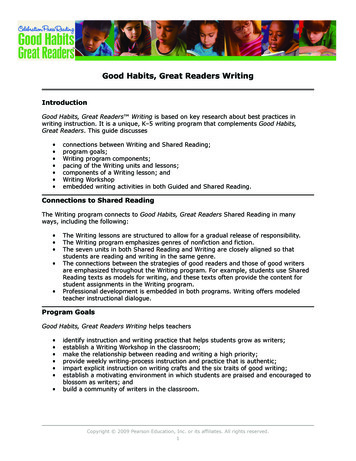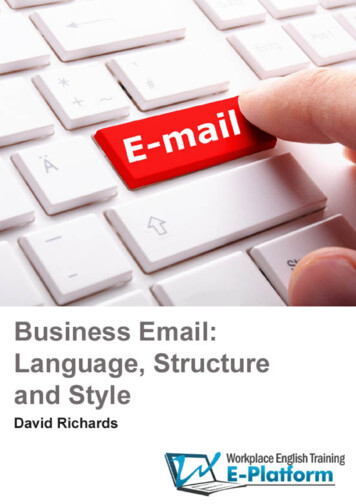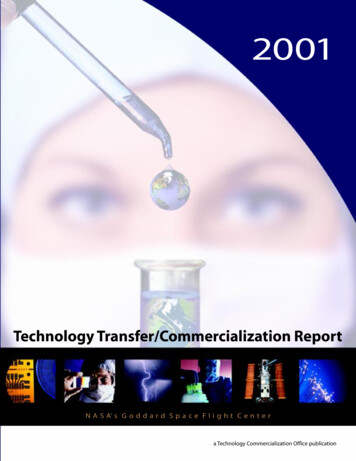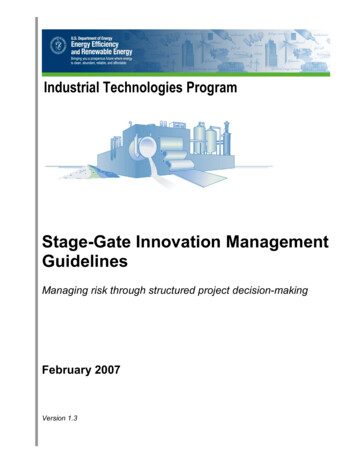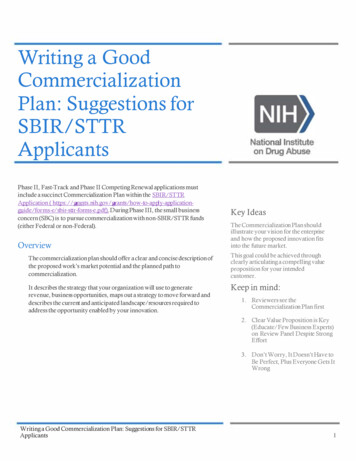
Transcription
Writing a GoodCommercializationPlan: Suggestions forSBIR/STTRApplicantsPhase II, Fast-Track and Phase II Competing Renewal applications mustinclude a succinct Commercialization Plan within the SBIR/STTRApplication ( httl)s: / /grants.nih.gov/grants/how-to-apply-application guide/forms-e/ sbir-sttr-forms-e.pdf).During Phase III, the small businessconcern (SBC) is to pursue commercialization with non-SBIR/STTR funds(either Federal or non-Federal).OverviewationaJ Instituteon Drug Abuse,Key IdeasThe Commercialization Plan shouldillustrate your vision for the enterpriseand how the proposed innovation fitsinto the future market.The commercialization plan should offer a clear and concise description ofthe proposed work's market potential and the planned path tocommercialization.This goal could be achieved throughclearI y articulating a compelling valueproposition for your intendedcustomer.It describes the strategy that your organization will use to generaterevenue, business opportunities, maps out a strategy to move forward anddescribes the current and anticipated landscape/resources required toaddress the opportunity enabled by your innovation.Keep in mind:1. Reviewers see theCommercialization Plan first2. ClearValueProposition isKey(Educate/Few Business Experts)on Review Panel Despite StrongEffort3. Don't Worry, ItDoesn't Have toBe Perfect, Plus Everyone Gets ItWrongWriting a Good Commercialization Plan: Suggestions for SBIR/ STTRApplicants1
ObjectivesAs it is specified in the SBIR/STTRApplication Guide ( SF424 (R&R)SBIR/STTR Application Guide for NIH and Other PHS Agencies),potential applicants are to create a document entitled" CommercializationPlan", no longer than 12 pages, and to provide a description of each of thefollowing areas:A.Value of the SBIR/STTR Project, Expected Outcomes, and ImpactsB. Company OverviewC. Market, Customer, and Competition Analysis (TPP or Equivalent)D. Intellectual Property (IP) ProtectionE. Regulatory StrategyF. Finance PlanG.Production andMarketingPlanH. Revenue StreamI. Risk Analysis/Mitigation StrategyA) Value of the SBIR/ STTRProject, ExpectedOutcomes, and ImpactA good starting point for writing a commercialization plan is a clearlywritten statement that identifies the overall commercial goal of the project.This is your vision of what the product will do to meet a need and whomthe project will affect.Define the specific problem or opportunity addressed and its importance.The project and key technological objective(s) should describe enough ofthe technical aspects of the project in order for experts to appreciate thetechnical merit, without going too deep into detail. Also keep in mind thatfailure to give sufficient detail may cause knowledgeable readers toquestion credibility.Give a brief background/history that suggest there is a real problem whichyour project is addressing. The background should only be detailed enoughto outline why there is a need for action to be taken. If applicable, state theadvancements that have happened which has allowed your projecttoaddress the issue/ problem Expand on how your project creates a bettersolution to the previous! y addressed concern, specifying weaknesses in thecurrent approaches (The advantages compared to competing products orservices).Describe the commercial applications of the research. List the potentialimpact a successful project could have. Identify key technical objectivesand general expectations in terms of market opportunities, potential futureproducts, or new areas of research. This is brief overview of the market, amore detailed look into the market will follow in section C.Writing a Good Commercialization Plan: Suggestions for SBIR/STTRApplicantsPoints of Emphasis Commercial and societal benefitsCompetitive advantage overexisting technologyOutline of Part A. Overall goal/objectiveThe product, the problem itsolves, and benefitsHistoryIpast data suggesting aproblemThe advantages compared tocompeting products or servicesRecent advancementsCommercial applicationMarket potential, future markets,new researchNon-commercial impactSBIR/STTR integration withbusiness plan2
Be sure to highlight the non-commercialimpacts to the overall significanceof your project (specify the potential societal, educational, and scientificbenefits of this work). Then finally touch on how the SBIR/STTR projectintegrates with the overall business plan of the company.B) Company OverviewThe company overview is asking for a brief description of the company togive the reviewers a better understanding of the company as a whole. Theyare looking for basic information such as when the organization wascreated, present number of employees, corporate objectives, corecompetencies, and a short description of the company origins. If thecompany consists of only a few employees then you should describe thecapabilities of the team specifically as they relate to the commercializationof your technology.Organizer: Christopher C. King, Founder& CEO, We Are Marcus - He is as ocial entrepreneur, activist, and educator. He earned his MBA fromHaward University School of Business in 2018, MPA from Baruch College,A ustin Marxe School of Public Affairs. He recently DC's premierAccelerator at 1776. The beta-launch of his product spans across severalstates in the US- including NYC, DC, Charlotte and abroad in London,Dubai, Capetown, Ghana, and Jamaica. He has been featured in BlackEnterprise and recently m oderated at National PublicRadio. Beyond theseachievements, he brings with him a decade of diverse experiences fromhigher learning, consulting at Intel Corporation, to working on theoperations stafffor President Barack O bama in 2012.Points of Emphasis Outline of Part B.Company information including: Go into detail when listing previous history ofFederal and non-Federalfunding, regulatory experience, and subsequent commercialization, andany current products/ services that have significant sales. These pastfunding experiences, if applicable, should show that the funding awardedfor the project was adequately used and provided a favorable outcome forthe company. Include your vision for the future in the short and long run. How will yougrowImaintain a sustainable business entity? Will you meet criticalmanagement functions as your company evolves?C) Market, Customer and CompetitionMarket size is defined by total annual sales of products that address amarket's particular need. But one has to be specific about what themarket's needs are. If applicable, when considering the market you aretargeting, break it into primary, secondary and tertiary customer bases.This will help you to describe the target market segments and size whileproviding a brief profile of the potential customers.Relevant commercializationcapabilities of your team [ShortBios- Business Experts First]Tap into your Board of Directorsor Scientific Advisory BoardProduct lines that showsuccessful marketimplementation [e.g. Servicesthat the company provides]Corporate objectivesCore competenciesPresent size, products/serviceswith significant salesHistory of previous Federal andnon- Federal fundingRegulatory experienceHow the company plans todevelop from a small technologyR&D business to a successfulcommercialentityPoints of Emphasis Know your market and marketneedsWhen identifying these markets, it is useful to ask the questions why targetthese markets, what are the benefits and what data and studies wouldsupport this conclusion Statistical data that shows the potential marketWriting a Good Commercialization Plan: Suggestions for SBIR/STTRApplicants3
size, market trends in the area and potential profits from capturing apercentage of the market may be of use. For Example, 10% penetration into a 2B market results in annualsales of 200M. If a 2B market is growing at 10% a year and yourproduct can capture 50% of new patients, then first-year saleswould be 1 00M, followed by 21OM in the second year, 330 inthe third and so on.Overestimating market penetration is a common mistake. Take intoconsideration whether or not it is easy to gain market shares in a mature,slow growing market. Look at how other competitors penetrated into thesame or similar markets.TAM highest potentialof people who couldpossibly buyTotalAvailableMarketServedAvailableMarketTarget Market low-hangingfruit; most easily and likelyto buySAM people reached viacurrent and standard saleschannelsClearly explain the Target Market [Will Later be ExapndedUpon/Customer Section of the Commercialization Plan - Personas]Market characteristics to consider would be the motivation of customers tobuy the product, number of people that could potentially utilize theproduct, and selling characteristics that make your project appealing.Keepin mind and reiterate the need for the product on the market and beproactive in identifying, characterizing and marketing for the future. Incases where no comparable products exist to estimate a market's size, lookat comparable markets and analogous products.Make clear the advantages your product will bring to the market. How is itbetter than your competitors or previous way of meeting the need beingaddressed. For example: betterperformance, lower cost, faster, moreefficient or effective, or new capabilities. Explain the hurdles you will haveto overcome in order to gain market/customer acceptance of yourinnovation. [Leads into your next section, Competitiors]Each customer actually consists of an end user and a decision-makingunit (DMU). The end user very likely is an integral part ofDMU but maynot be the most important person in it. More specifically:Writing a Good Commercialization Plan: Suggestions for SBIR/ STTRApplicants4
End User. The individual (a real person) who will use your product. Theend user is usual! y a member of the household or organization thatpurchases your product.DMU: the individual(s) who decides whether the customer will buyyour product, consisting of:ooChampion: the person who wants the customer to purchasethe product; often the end userPrimary economic buyer: the person with the authority tospend money; sometimes this is the end user. Influencers,Saboteurs, Purchasing departments: people who have sway todirect control over the decisions of the Primary economicbuyerYou will find much variety among the end target users. But as a startup,you will have to exclude many potential customers in order to stay focusedon a key group of relatively homogeneous end users, who will providemuch needed initial cash flow. In biotech, the end users (customer whowill use your product) is not the same person who makes the purchasedecision (the buyer). The buyer often has distinctive needs from the enduser that need to be addresses to achieve PMF, and you should define yourtarget buyer in addition to your target end user when warranted.D) Intellectual Property (IP) ProtectionThis section should summarize how the company will protect theintellectual property that enabI es commercialization of its products whilekeeping competitors at bay. Should take note if the company plans to issueadditional patents throughout the process. What patents protect the project or idea and to whom do theybelongPoints of Emphasis List current patents or describehow the company plans toprotect the IPIf the company does not already have the IP it needs discuss thelicensing/filing strategy to make sure that no one else gets it first. Ifapplicable, note other actions that the company may consider to constitutetemporal barrier to others aiming to provide a similar soluti.on.E) Regulatory StrategyDescribe the regulatory strategy that you are going to be undertaking tomove your product towards the market. Outline how you plan to addressdata compliance and security(as this has become a very senstitive and bigproblem in the space).F) Finance PlanStart off with estimations of raised financing broken out by the differentphases. The assumptions in phase II/III should identify the ti ming of thefinancial event(s) and milestones the company hopes to achieve in theWriting a Good Commercialization Plan: Suggestions for SBIR/STTRApplicants5
forecasted time period These should clearly describe the timing andfinancial needs to commercialize the product, process or service.Sources of Funding forCommercializationSBIR/STTR firm itself; private investorsor" angels"; venture capital firms;investment companies;ejoint ventures;R&D limited partnerships; strategicalliances; research contracts; sales ofprototypes (built as part of this project);public offering; state finance programs;non SBIR-funded R&D or productioncommitments from a Federal agency withthe intention that the results will be usedby the United States government; or otherindustrial firms.Entrepreneur,family, friends,businessangels, publicsourcesExpansionLate/POFinancing stageDI eoveryPreclinical Developmentnd e.r1y Cllnle 1 T IsEarlyCommcrel llzatlonCash Flow30u::s:.Cl)n:,(.)Public SectorPrivate SectorPlans for financing may be demonstrated through one or more of thefollowing ways: Letter of commitment offundingWriting a Good Commercialization Plan: Suggestions for SBIR/STTRApplicants6
Letter of intent or evidence of negotiations to provide funding,should the Phase II project be successful and the market need stillexistLetter of support for the project and or some in-kind commitment,e.g. to test or evaluate the innovationSpecific steps you are going to take to secure Phase III fundingApplicants are encouraged to seek commitment(s) of funds and/ orresources from an investor or partner organization for commercializationof the product(s) or service(s) resulting from the SBIR/STTR grant. PhaseIII funding may be from any of a number of different sources.G) Production and Marketing PlanTwo Key Questions:1. Which potential buyers shouldthe company attempt to serve?2. How much customization shouldthe firm offer in its programs, i.e.at which point on the marketcontinuum will the firm constructplans:Describe how the production of your product/process/service will occur.Describe each step involved with taking your product to the market to sellwhich may include plans for licensing or internet sales.4P's1.2.3.4.ProductPlace (Channels ofDistribution)Promotione(Communications Strategy)PricingProduct: Should not be the thing itself but rather the total package ofbenefits obtained by the customer. Afterintroducing a new product to themarket there should be a process of Product Life Cycle Managementwhere the company continually tries to learn more about consumers fromtheir reactions to the introduced product.Place: The marketing channel is the set of mechanisms or networks fromwhich a company takes their product to market with its customers for avariety of tasks.Promotion: Determining the appropriate ways to communicate withcustomers to foster awareness, knowledge about its features, interest inpurchasing, likelihood of trying the product and or repeat purchasing.Pricing: The value of the product can come from the customers perceptionor the actually productoPlaceChannel Design Distribution via direct, indirectorboth ways Proper design of contracts, goodcommunicationChannel Management What policies and procedureswill be used to have the necessaryfunctions performed by thevarious parties?Promotion H) Revenue StreamMass Market- MarketSegments- Market NichesIndividualsMarket- to whom is thecommunication to be addressedMission- what is the objective ofthe communicationMessage- what are the specificpoints to be communicatedMedia- which vehicles will beused to convey the messageMoney- how much will be spentin the effortMeasurement- how will impactbe assessed after the campaignThis section describes exactly how you plan to make money selling yourproduct developed as the result ofNIDA SBIR/STTR funding. A clearly laidout explanation on how you plan to generate a revenue stream mayincorporate many tools such as revenue model estimations, charts, and graphsto display timeline goals. If a market is large and fragmented enough apotential option would be to partner with other companies with a provenhistory of generating revenue. Also take note of whether the company is a wellWriting a Good Commercialization Plan: Suggestions for SBIR/STTRApplicants7
diversified company that has multipie products with few shared risk factors, orif the company is developing a single product where the risks may be morecentralized.Examples of revenue steam generation include but are not limited to: Manufacture and direct salesSales through value added resellers or other distributorsJoint ventureLicensingServiceI) Risk AnalysisThis section describes all possible risks to the proposed to be developmedproduct and mitigation strategies.Strengths(internal, positive)Weaknesses(internal, negative)Opportunities(external, positive)Threats(external, negative)Strength-Opportunity strategiesStrength-Threats strategiesWhich of the company's strengthscan be used to maximize theopportunities you identified?How can you use the company'sstrengths to minimize the threatsyou identified?Weakness-Opportunity strategiesWeakness-Threats strategiesWhat action(s) can you take tominimize the company's weaknessesusing the opportunities you identified?How can you minimize thecompany's weaknesses to avoid thethreats you identified?Writing a Good Commercialization Plan: Suggestions for SBIR/STTRApplicants8
Plan", no longer than 12 pages, and to provide a description of each of the following areas: A.Value of the SBIR/ STTR Project, Expected Outcomes, and Impacts B. Company Overview C. Market, Customer, and Competition Analysis (TPP or Equivalent) D. Intellectual Property (IP) Protection E. Regulatory Strategy F. Finance Plan
